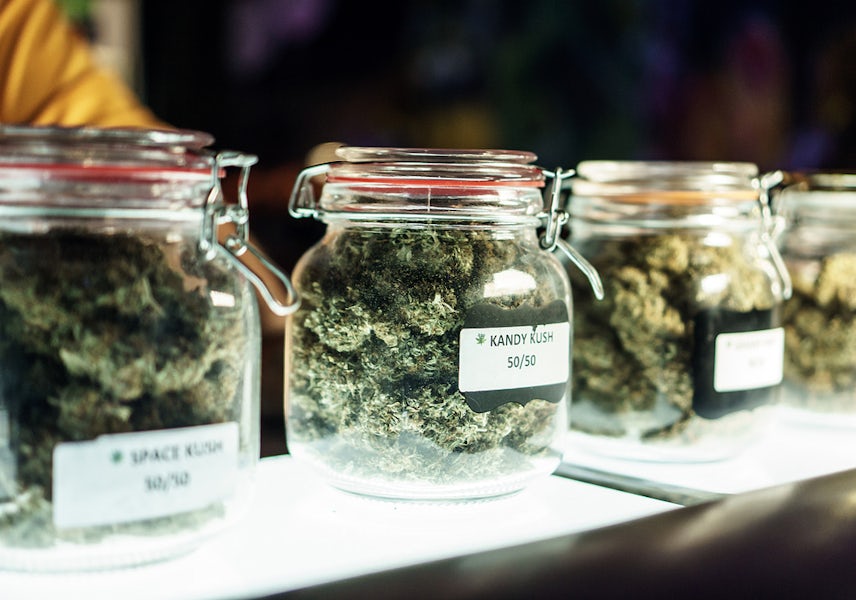If your head is throbbing, you probably wouldn’t think to tie on a headband — but you might want to smoke one.
The acclaimed cannabis chemovar (strain) “Headband” was named as one of the three most popular for migraine and headache patients, in a new study released in June, 2021.
The study, compiled by Dr. Eric Baron from the Cleveland Clinic and Philippe Lucas from cannabis firm Tilray, surveyed 346 migraine patients using cannabis. The patients were asked to assess how often they consume cannabis and in what quantities, their primary method of use, and their preferred cannabis cultivars and cannabinoid and terpene profiles.
Six of the eight chemovars preferred by the migraine patients were high in THC and low in CBD. The top three most-preferred chemovars had beta-caryophyllene as one of their top three terpenes, in addition to a mix of humulene, bisabolol, β-myrcene, linalool, and limonene, among others.
The researchers found that the most popular chemovars among migraine sufferers, all tied for the top spot, were Tilray’s:
- Headband
- Warlock CBD
- Master Kush
Terpenes are the molecules that are responsible for the smell and taste of different cannabis varieties and may also play a role in how they make you feel. Research has found that the terpenes in a strain may help determine whether or not a cannabis chemovar produces a more relaxing or sedative high, much more than whether or not people call it an indica or sativa, which is something of a misnomer anyway.
In order of prevalence, the most common terpenes in the Headband samples administered were:
- Beta-caryophyllene
- Linalool
- Humulene
- Bisabolol
- Limonene
- Trans-nerolidol
- Myrcene
- Pinene
For Warlock CBD they were:
- Limonene
- Myrcene
- Beta-caryophyllene
- Humulene
- Trans-nerolidol
- Linalool
- Pinene
For Master Kush, the most common were:
- Linalool
- Bisabolol
- Beta-caryophyllene
- Limonene
- Humulene
- Trans-nerolidol
- Myrcene
- Pinene
Inhalation was the preferred intake method named by 64.5% of the headache patients. Inhalation could be a more effective method for as-needed relief of a throbbing headache, as it has a virtually instantaneous onset, unlike ingestibles which can take an hour or more to kick in.
On average, patients in the sample group consumed 9.4 grams of cannabis per week.

The researchers also found that 41.5 % of patients with headache pain as their primary symptom had substituted opioids medications with medicinal cannabis in the previous year.
The researchers concluded that the chemovar preferences shown by the respondents could “ reflect the potent analgesic, anti-inflammatory, and anti-emetic properties of THC,” along with the anti-inflammatory and analgesic properties of the terpenes in the particular chemovars.
They also stated that their findings mirror a previous study they carried out in 2018. In that study, which was published in the “Journal of Headache and Pain,” the researchers used an online survey to ask medicinal cannabis patients about their intake methods, frequency, quantity, preferred chemovars, and prescription medicine substitutions.
In that study, the researchers found that the most popular chemovar was “OG Shark,” and that hybrid chemovars were the most popular across all pain sub types. The study describes OG Shark as a chemovar with high THC and low CBD, with significant levels of beta-caryophyllene and beta-myrcene, which were the most popular in the headache and migraine groups.
In addition to the analgesic, anti-inflammatory, and antiemetic properties of THC, the popularity of OG Shark could be related to the anti-inflammatory and analgesic properties of beta-caryophyllene and beta-myrcene, they wrote.
The researchers noted that the study did have a number of limitations. Many of the patients who reported headaches as a primary symptom were also using medical cannabis to treat other diseases and symptoms, meaning that their answers may not have been specific to headache treatment. Also, many of the patients reporting chronic pain may have meant chronic headache pain. In addition, many of the participants had less knowledge about cannabis chemovars, and did not provide an answer for which type of chemovar they prefer.
Sign up for bi-weekly updates, packed full of cannabis education, recipes, and tips. Your inbox will love it.

 Shop
Shop Support
Support
















